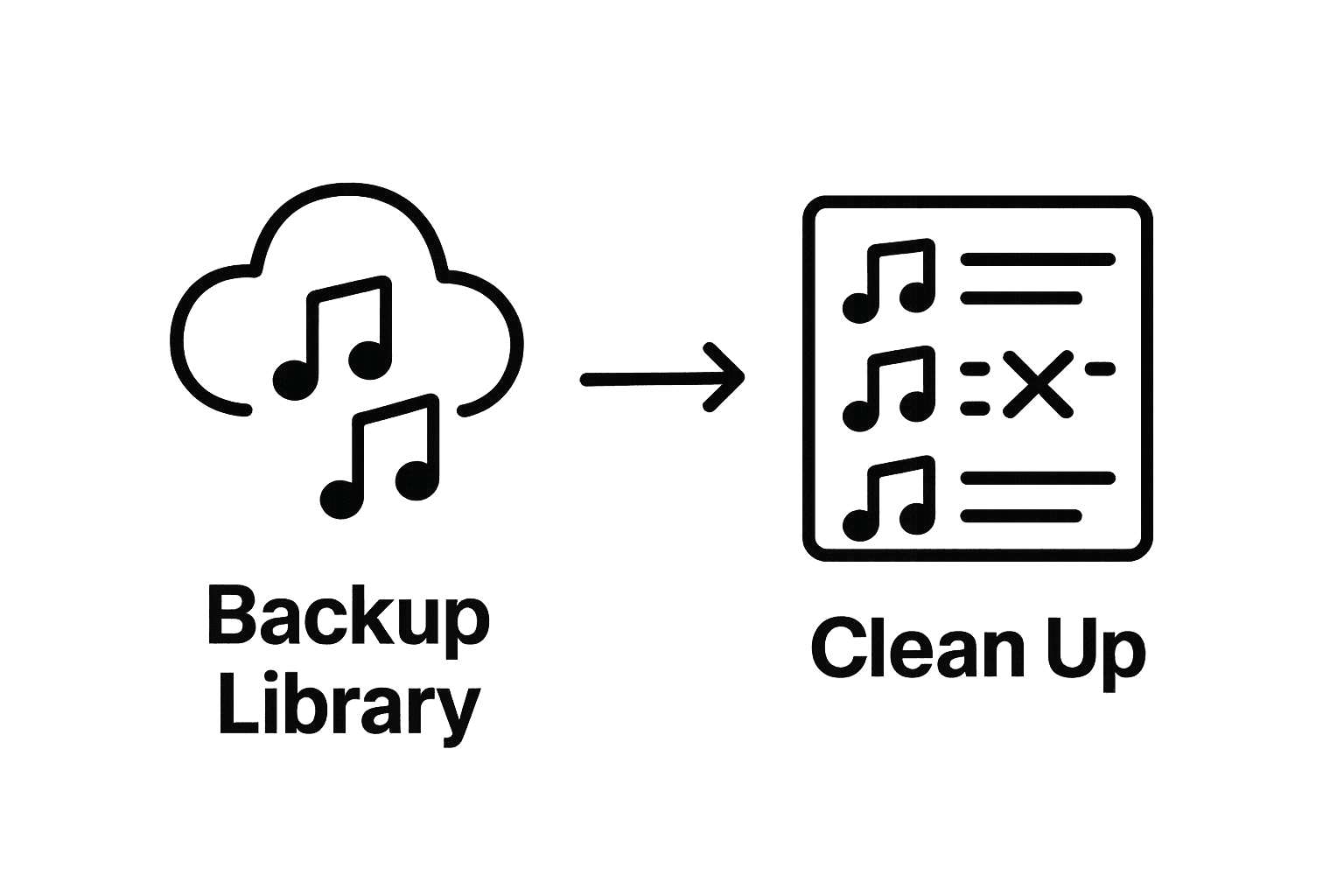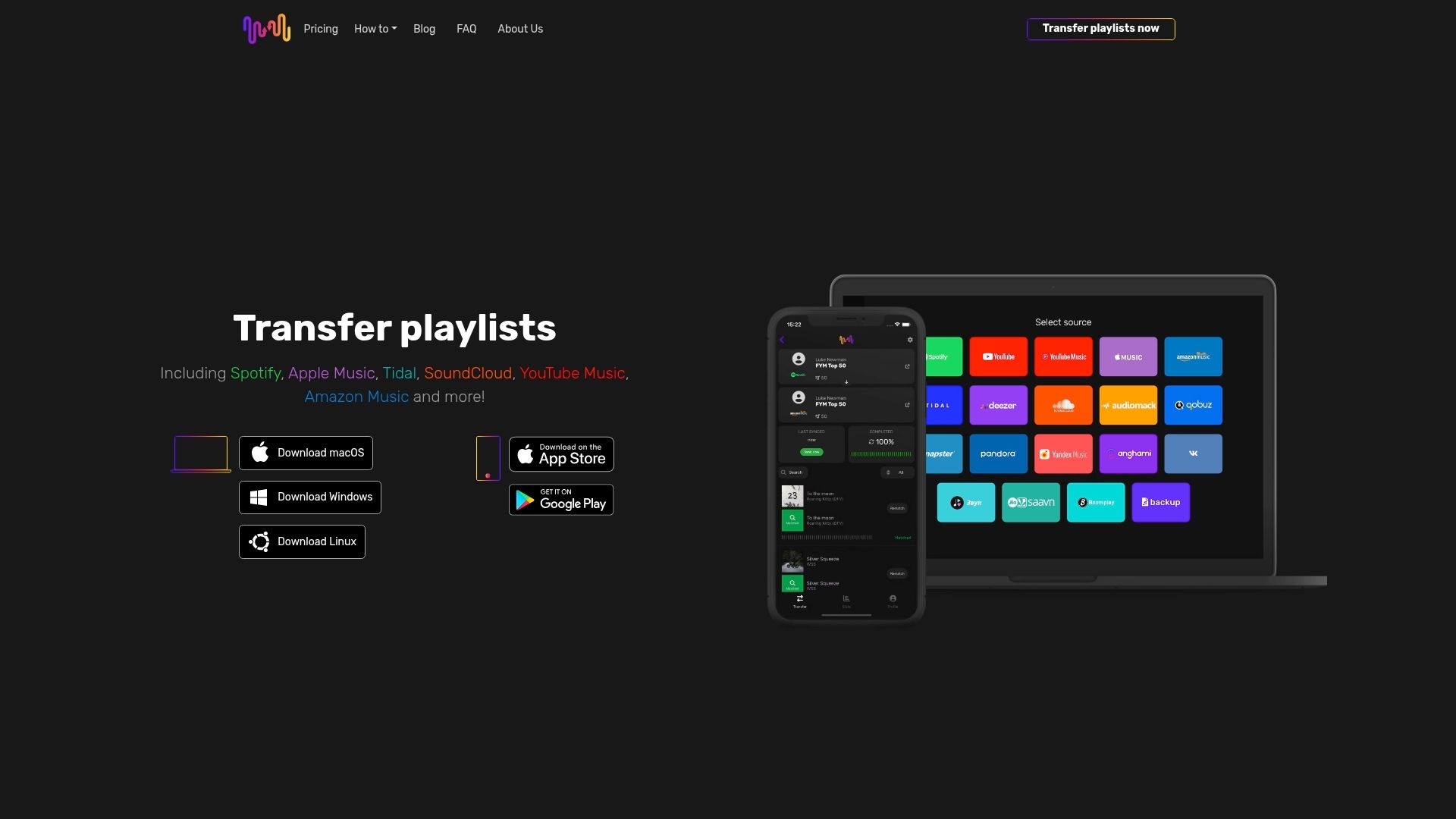Moving your music library might sound like a digital headache, especially if you have years of playlists and favorites built up across different streaming platforms. But here is a surprise. Some music fans juggle over 200 playlists and thousands of unique tracks across three or more services. Most people think the transfer will turn into a total mess, but the right method can actually make switching seamless and stress-free.
Table of Contents
- Step 1: Assess Your Current Music Library Status
- Step 2: Choose The Right Music Transfer Tool
- Step 3: Prepare Your Music Files For Transfer
- Step 4: Execute The Transfer Process Step-By-Step
- Step 5: Verify Successful Transfer And Adjust Playlists
Quick Summary
| Key Point | Explanation |
|---|---|
| 1. Assess your music library first | Evaluate your current music collection to understand its structure, playlists, and unique features before transferring to another platform. |
| 2. Choose a compatible transfer tool | Select a music transfer tool that supports your source and destination services and preserves important metadata and playlist organization. |
| 3. Back up your music collection | Create multiple backups of your music library to protect against data loss during the transfer process, using different storage methods. |
| 4. Monitor the transfer process | Keep an eye on the migration in real-time to catch and resolve any issues immediately, ensuring a smooth transition of your music library. |
| 5. Verify transferred data thoroughly | After migration, confirm that all playlists and tracks are intact and correctly ordered by comparing them against your original library. |
Step 1: Assess Your Current Music Library Status
Transferring your music library starts with a comprehensive evaluation of your current digital music collection. This critical first step involves understanding the full scope, structure, and unique characteristics of your music library before initiating any migration process. By carefully examining your existing library, you'll create a strategic roadmap that minimizes potential data loss and ensures a smooth transition between music streaming platforms.
Begin by collecting detailed information about your current music library. Open each streaming service where you maintain playlists and carefully document key details. Pay special attention to the total number of playlists, unique tracks, and any custom or collaborative playlists that might require extra attention during transfer. Total playlist count, track diversity, and unique organizational structures are crucial factors that will influence your migration strategy.
Your assessment should include a thorough inventory that captures multiple dimensions of your music collection. Manually count or use built-in service analytics to understand playlist sizes, track genres, creation dates, and any specialized folders or groupings you've developed. Some streaming platforms offer export features that can help you generate comprehensive reports about your library's composition. For more complex libraries, consider using specialized music library management tools that can provide deeper insights into your collection's structure.
Verify the compatibility of your current library with potential destination platforms. Not all streaming services support identical features, so understanding potential translation challenges is crucial. Some platforms might have limitations on playlist length, specific track availability, or unique playlist organization methods. Research from the National Association of Schools of Music suggests creating a detailed compatibility matrix that compares your source and target platforms' capabilities.
To streamline your assessment, focus on these key verification points:
- Total number of playlists
- Number of unique tracks
- Playlist size variations
- Presence of collaborative or shared playlists
- Any region-specific or restricted tracks
By meticulously documenting your current music library's composition, you'll develop a comprehensive migration strategy that preserves your musical collection's integrity. This preparatory step transforms a potentially complex transfer into a manageable, systematic process. Learn more about playlist migration techniques to further enhance your understanding of the transfer process.
Step 2: Choose the Right Music Transfer Tool
Selecting the appropriate music transfer tool represents a pivotal moment in your library migration journey. This critical step determines the efficiency, accuracy, and overall success of moving your cherished music collection between streaming platforms. The right tool can transform a potentially complex migration into a seamless, stress-free experience.
Not all music transfer tools are created equal, and your selection should be based on several key considerations. Begin by evaluating the specific requirements of your music library, including total playlist count, unique track variations, and the source and destination streaming platforms. Some tools specialize in specific service-to-service transfers, while others offer more comprehensive cross-platform capabilities. Carefully research tools that support both your current and target music streaming services to ensure complete compatibility.
Pay close attention to the tool's features and technical capabilities. Look for solutions that preserve playlist metadata, maintain track ordering, and handle potential discrepancies in music catalog availability. Advanced transfer tools should offer features like duplicate track detection, playlist size preservation, and the ability to handle collaborative or shared playlists. Some premium tools provide additional benefits such as cloud backup, automatic synchronization, and multi-account support, which can significantly enhance your migration experience.
Budget and pricing models are another crucial factor in your tool selection. While some music transfer services offer free basic transfers, more comprehensive solutions might require a subscription or one-time payment. Evaluate the tool's pricing structure against the complexity of your music library and the depth of features provided. Research from the National Association of Schools of Music suggests that investing in a robust transfer tool can save significant time and prevent potential data loss.
Consider these key verification points when selecting your music transfer tool:
- Cross-platform compatibility
- Metadata preservation capabilities
- Track matching accuracy
- User interface intuitiveness
- Customer support quality
- Pricing and value proposition
Before committing to a specific tool, take advantage of free trials or demo versions to test its performance with a subset of your music library. Explore our detailed guide on playlist migration techniques to gain deeper insights into selecting the most suitable transfer solution. By meticulously evaluating your options, you'll choose a tool that ensures a smooth, reliable migration of your musical collection.
Step 3: Prepare Your Music Files for Transfer
Preparing your music files for transfer is a meticulous process that requires careful attention to detail and strategic planning. This crucial step involves organizing, cleaning, and optimizing your music library to ensure a smooth and accurate migration between streaming platforms. Proper preparation can significantly reduce potential data loss and minimize transfer complications.

Start by creating a comprehensive backup of your entire music library across all current streaming platforms. This backup serves as a safety net, protecting your musical collection from potential transfer errors or unexpected data complications. Utilize built-in export features or specialized backup tools that can generate complete playlist exports, including track metadata, playlist names, and any custom organizational structures you've developed. Consider storing these backups in multiple locations, such as cloud storage and an external hard drive, to ensure maximum data protection.
Next, conduct a thorough review and cleanup of your music library. Identify and address potential issues like duplicate tracks, incomplete metadata, or tracks with inconsistent naming conventions. Pay special attention to playlist titles, track names, and artist information, as these elements can sometimes cause matching challenges during the transfer process. Some music transfer tools offer built-in cleanup features that can help standardize and optimize your library's structure, making the migration process more streamlined and accurate.
Carefully examine playlist compositions and consider potential platform-specific limitations. Different streaming services have varying restrictions on playlist lengths, track availability, and organizational capabilities. You might need to make strategic decisions about which playlists to prioritize or potentially split larger playlists into multiple smaller collections. Research from the National Association of Schools of Music emphasizes the importance of understanding platform-specific constraints before initiating a transfer.
Consider these critical preparation steps:
- Create multiple backup copies of your music library
- Remove duplicate tracks and clean metadata
- Verify track availability across target platforms
- Standardize playlist and track naming conventions
- Document any unique or complex playlist structures
As a final verification step, run a preliminary test transfer using a small subset of your music library. This approach allows you to identify potential issues and refine your transfer strategy before committing to a full library migration. Learn more about file backup strategies to enhance your preparation process. By meticulously preparing your music files, you'll set the stage for a smooth, reliable transfer that preserves the integrity of your musical collection.
Step 4: Execute the Transfer Process Step-by-Step
Executing your music library transfer requires a methodical and strategic approach that balances technical precision with careful attention to detail. This critical phase transforms your preparation work into an actual migration of your musical collection across streaming platforms. The success of your transfer depends on following a structured, deliberate process that minimizes potential data loss or playlist disruption.
Begin by launching your selected music transfer tool and carefully configuring its settings to match your specific migration requirements. Carefully review the tool's interface and ensure you have correctly selected both your source and destination streaming platforms. Take time to verify login credentials and connection permissions for each service, as authentication issues can interrupt the transfer process midway. Most modern transfer tools will provide a step-by-step wizard that guides you through connection and authorization processes, making this initial setup relatively straightforward.
Once authenticated, carefully review the transfer settings and options. Pay close attention to playlist transfer preferences, including how the tool handles duplicate tracks, playlist ordering, and metadata preservation. Some advanced transfer tools offer granular controls that allow you to customize how playlists are migrated, such as selecting specific playlists for transfer or setting rules for track matching. If your transfer tool provides a preview feature, use it to verify that the selected playlists and tracks align with your expectations before initiating the full transfer.
Research from the National Association of Schools of Music emphasizes the importance of monitoring the transfer process in real-time. During the migration, maintain an active watch over the transfer progress, noting any error messages or interruptions. Most reliable transfer tools provide detailed logs and progress indicators that help you track the migration's status. Be prepared to pause or restart the transfer if significant issues arise, and always have your backup files readily accessible.
Consider these critical execution checkpoints:
- Verify source and destination platform connections
- Review and confirm transfer settings
- Monitor transfer progress in real-time
- Check for any error messages or interruptions
- Validate transferred playlist integrity
After the transfer completes, perform a comprehensive verification of your new music library. Manually review several playlists to confirm track count, ordering, and metadata accuracy. Learn more about playlist migration techniques to enhance your understanding of potential transfer nuances. By executing the transfer with patience and systematic attention, you'll successfully migrate your musical collection while preserving its unique character and organization.
Step 5: Verify Successful Transfer and Adjust Playlists
Verifying the successful transfer of your music library represents the final critical checkpoint in your migration journey. This meticulous process ensures that every playlist, track, and musical nuance has been accurately transferred to your new streaming platform. A comprehensive verification strategy is your ultimate safeguard against potential data loss or organizational disruption.
Immediately after completing the transfer, conduct a systematic review of your newly migrated music library. Open the destination streaming platform and methodically compare each transferred playlist against your original library. Pay close attention to playlist length, track ordering, and any potential discrepancies in metadata. Some tracks might not transfer perfectly due to differences in music catalog availability across platforms, so be prepared to manually adjust and recreate playlists if necessary. Carefully check the total number of tracks in each playlist to confirm no significant data has been lost during the transfer process.
Utilize the comparative analysis approach by opening both your source and destination platforms simultaneously. This side-by-side verification allows you to quickly identify any missing tracks, incorrect metadata, or playlist structure variations. Some music transfer tools provide comprehensive comparison reports that highlight potential transfer inconsistencies. Take notes on any discrepancies you discover, as these will guide your manual playlist adjustments. Consider creating a spreadsheet to track and resolve any transfer-related issues systematically.
Research from the National Association of Schools of Music emphasizes the importance of manual intervention during the verification stage. While automated transfer tools are powerful, they cannot always perfectly replicate the nuanced structure of your original music library. Be prepared to spend time manually adding missing tracks, recreating playlist orders, and ensuring that collaborative or custom playlists maintain their original intent.
Consider these critical verification checkpoints:
- Confirm total playlist count matches original library
- Verify track count in each playlist
- Check metadata accuracy for transferred tracks
- Identify and resolve any missing or incorrectly transferred songs
- Recreate playlist structures if necessary
If significant discrepancies emerge, do not panic. Most music transfer tools offer retry options or detailed error logs that can help you understand and address transfer challenges. Learn more about playlist migration techniques to refine your verification strategy. By approaching this final step with patience and systematic attention, you'll ensure a successful migration that preserves the essence of your musical collection.
Here is a helpful checklist table to verify the accuracy and integrity of your music library after completing the transfer process.
| Verification Step | What to Check | Why It Matters |
|---|---|---|
| Playlist count | Confirm number of playlists matches original library | Ensures no playlists are missing |
| Track count per playlist | Verify number of tracks in each playlist | Detects if songs were lost or skipped |
| Metadata accuracy | Check song titles, artist names, and album info | Maintains organization and correct identification |
| Missing songs | Identify and recover any missing tracks | Restores completeness of playlists |
| Playlist order | Ensure track order matches original | Preserves intended listening experience |
| Collaborative/shared playlists | Verify collaborative and special playlists transferred | Maintains unique playlist structures |
| Playlist structure | Check folders or groupings if supported | Retains custom organization |

Ready to Take the Stress Out of Moving Your Music Playlists?
You have invested countless hours crafting the perfect playlists and organizing your music library. The thought of losing playlist structure, track order, or experiencing data loss during a migration can be overwhelming. As discussed in the article, careful preparation and attention to metadata, playlist ordering, and seamless transfer tools are all crucial for a smooth transition. You deserve a solution that does the heavy lifting for you while preserving your listening experience—no matter which platforms you are switching between.

With Free Your Music, you can skip the hassle of manual rebuilding and let our powerful app streamline your migration. Effortlessly transfer unlimited playlists, ensure all your favorites arrive safely, and keep your playlists perfectly organized across Spotify, Apple Music, Tidal, YouTube Music, Amazon Music, and more. Protect your collection with cloud backup and expert customer support ready to guide you. If you want the most accurate, reliable music migration, learn more about our playlist migration techniques or get started with Free Your Music now. Make your next move easy—your playlists will thank you.
Frequently Asked Questions
What should I consider when assessing my current music library status before transferring?
Begin by documenting the total number of playlists, unique tracks, and any custom or collaborative playlists. It's also important to understand the structure of your collection and verify compatibility with the target platform.
How do I choose the right music transfer tool for my library migration?
Evaluate tools based on their compatibility with your source and destination streaming platforms, their features for preserving metadata and track ordering, and consider their pricing models. Testing free trials can also help in making an informed choice.
What are the critical steps to prepare my music files for transfer?
Create backups of your music library, clean up any duplicates or inconsistent metadata, and standardize playlist and track naming conventions. This preparation is essential for minimizing potential data loss during the migration process.
How can I verify that my music library was transferred successfully?
Conduct a systematic review of your new music library by comparing playlist lengths, track count, and metadata accuracy between the original and the destination platforms. Manual adjustments may be necessary to address any discrepancies.






